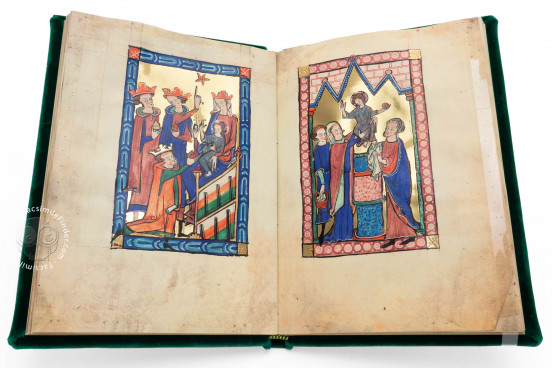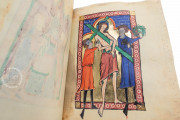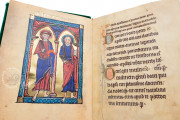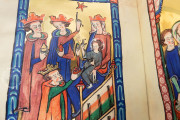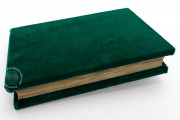The Carrow Psalter is a book designed for use in the private devotions of a Christian layperson. Made in East Anglia around 1250-1260, it is named for the nunnery where the book was kept in the fifteenth century. Its twenty-six full-page miniatures and twelve historiated initials are fine expressions of English Gothic manuscript art, all featuring backgrounds of burnished gold leaf. Most remarkable is the opening initial of the section of the biblical psalms, which features scenes from the life of Saint Olaf.
The book is properly called a psalter-hours. It includes the usual contents of a devotional psalter of the period—a calendar, the biblical psalms, and Old and New Testament canticles—plus suffrages (short prayers) to saints, the Office of the Dead, the Hours of the Virgin, and the Psalter of the Virgin.
Full-Page Saints
The manuscript opens with suffrages to pairs of saints, and each of the first six miniatures shows two male saints standing under an arcade and silhouetted before a burnished gold ground (fols. 1-11). There follow scenes of the martyrdoms of two English saints—Edmond and Thomas Becket (fols. 13v and 15v), a double portrait of Saints Catherine and Margaret (fol. 17v), and the martyrdom of Saint Agatha (fol. 19v).
Two sequences of full-page miniatures of biblical scenes follow. The first series of eleven miniatures, some divided into multiple scenes, extends from the Creation of Eve to the Last Judgment (fols. 21-30). The second, which repeats five scenes from the first sequence, shows episodes from the Infancy of Christ and the Carrying of the Cross (fols. 31-35).
Spotlight on Saint Olaf
The large historiated initial B that opens the psalms contains scenes from the life of the sainted Olaf II (995-1030), King of Norway, who incited rebellion in his harsh measures to re-Christianize Norway and died in battle when attempting to return from exile. The saint is pictured crowned and with his trademark axe in four scenes (fol. 42r).
Added Coats of Arms
When the manuscript was in the possession of Carrow Priory, a Benedictine nunnery near Norwich, shields bearing the coats of arms of English aristocracy, as well as the arms of Saint George, patron saint of England, were added to eleven decorated initials (fols. 222-297).
Writing without "Feet"
The manuscript's text is written in the mannered version of Gothic Textualis known as Textus Sine Pedibus ("text without feet") because the vertical strokes of f, i, l, m, n, r, s, and u stop squarely at the baseline. Each psalm verse begins on a new line with a pen-flourished initial, alternating gold with blue flourishing and blue with red flourishes. Penwork line fillers at the ends of verses feature geometric and foliate motifs and a range of fish, birds, and other creatures.
Storied Ownership
After being at Carrow Priory, the manuscript came into the possession of John Baptist (1716-1780), Lord Caryll; George Galway Mills; David T. Powell (1772-1848); Bertram Ashburnham (1797-1878), Earl of Ashburnham; and Henry Yates Thompson (1838-1928). Henry Walters (1848-1931) purchased it in 1920 and bequeathed it to the Walters Art Gallery (now Walters Art Museum) in 1931.
We have 1 facsimile edition of the manuscript "Carrow Psalter": Salterio benedettino facsimile edition, published by Imago, 2023
Request Info / Price

